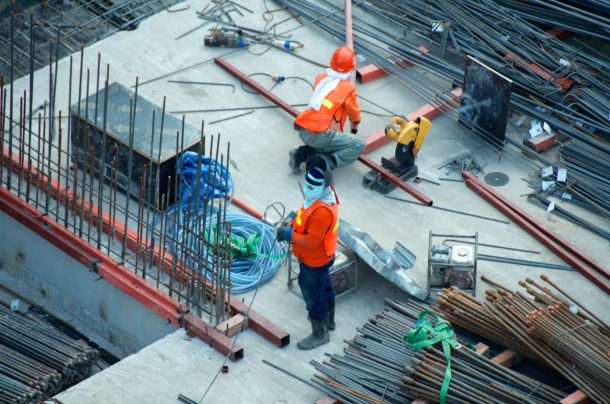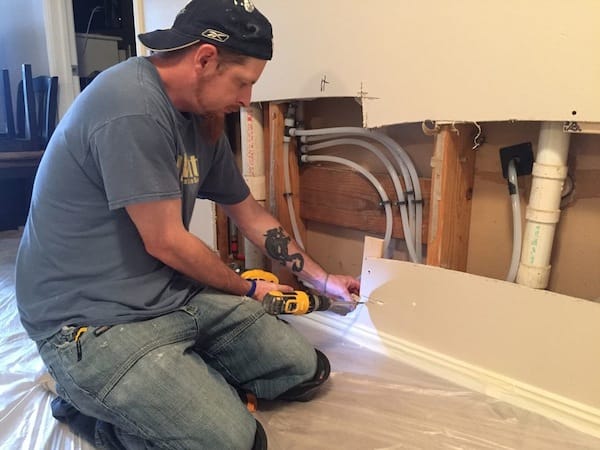If there is one thing that’s true about the construction industry, it’s that smaller businesses are the highest in turnover. More businesses in the construction industry pop up and then fail each year than most other industries.There are some companies that do stick it out, but they end up struggling for a while before folding Read more
Whats New

If there is one thing that’s true about the construction industry, it’s that smaller businesses are the highest in turnover. More businesses in the construction industry pop up and then fail each year than most other industries.There are some companies that do stick it out, but they end up struggling for a while before folding.
You can actually avoid any of this by doing your research properly at the beginning and then spending time learning how you can avoid it. For example, learning how to grow a construction business means learning how to research the right vendors, the right financial help, and the right outsourced IT services near me to get the job done. You need to ensure that you have the best possible support the whole time, and that means knowing what your construction business needs to be a long term success rather than a one hit wonder. Let’s take a look at some of the things that you will need to have in place before you get started.

- Good leadership. Companies don’t just happen and they don’t just become successful on their own. There needs to be good leadership in place for a company to be successful and that means that you need to have a vision and you need to have direction. These things should feel contagious to your staff and to those working for you, because they need to see that you have something in place to help yourself to grow. Once you develop that success and that growth mindset, you’ll be able to get others to believe in what you are hoping to achieve.
- A good accounting process. A business is not going to be a good business without a decent accountant on site to help you to learn what to do. If you don’t have a decent accounting process, then you really need to fire your accountant right now and get looking for a new one. You can’t grow without nailing down your financial numbers. So with solid accounting, you can make sure that you understand what’s going in and what’s going out of your business. From here, you can secure larger loans and larger investments from others.
- A positive cash flow. Every business that wants to find success needs to make sure that their cash flow is flowing positively and not negatively. This will help with a great accounting team on your side, but this is also something that you have to be aware of between tighter margins and waiting longer than other industries to get paid. Ensure that your business is still going to be maintainable and above water.
- The right legal help. As with any business, you need to ensure that yours has the right legal minds in place to be able to answer any questions about contracts and construction issues. A good construction attorney can make a very big difference to your business, and with the right legal help to hand, you’ll be able to avoid any lawsuits and deal with hard hats and hammers rather than suits and ties.

In the world of construction, efficiency is the name of the game. Time is money, and delays or inefficiencies can quickly eat into profits. The question that arises is: how do you achieve that? Streamlining construction operations is essential for staying competitive and profitable in this industry. In this article, we’ll explore various ways to Read more
In the world of construction, efficiency is the name of the game. Time is money, and delays or inefficiencies can quickly eat into profits. The question that arises is: how do you achieve that? Streamlining construction operations is essential for staying competitive and profitable in this industry.
In this article, we’ll explore various ways to simplify construction operations, focusing on relevant examples of how innovation can make a difference. Efficiency is not only about cost savings but also about delivering high-quality projects on schedule, meeting client expectations, and reducing the environmental footprint of construction activities. By examining these aspects, we can understand how to achieve efficiency in construction operations.

1. Optimizing Material Handling
Efficient material handling is a cornerstone of streamlined construction operations. Traditional methods often involve manual labor, which is time-consuming and prone to errors. This is where innovation comes into play. Ingenious devices have been developed to simplify moving and disposing of materials on-site.
These devices are designed to load materials quickly and can be transported by forklift or other machinery. The real magic happens when it’s time to unload. These devices tip with a simple lever pull, dumping their contents precisely where needed. This innovation eliminates the need for manual shoveling and labor-intensive material handling, saving time and reducing the risk of injuries. It’s a prime example of how investing in equipment can streamline construction operations.
2. Effective Waste Management
Waste management is another area where construction operations can be streamlined for efficiency. Construction generates a significant amount of waste, from discarded materials to debris. Handling and disposing of this waste can be challenging with the suitable systems in place. For instance, sturdy self-dumping hoppers play a vital role in waste management. By making collecting and transporting waste materials easy, they ensure that the job site remains clean and organized. These hoppers can be used in recycling efforts, further reducing waste and promoting sustainability. In addition to self-dumping hoppers, modern construction companies can benefit from implementing effective recycling and waste disposal strategies. This reduces the environmental impact and improves efficiency by keeping the work area clutter-free.
3. Streamlining Communication
Effective communication is the backbone of any successful construction project. Miscommunications can lead to costly errors and delays. To streamline operations, it’s essential to establish clear lines of communication among all team members. In today’s digital age, construction companies can use project management software and mobile apps to enhance communication. These tools allow for real-time updates, document sharing, and instant messaging among team members, on-site or in the office. When everyone involved in the project can access the latest information and communicate seamlessly, decisions can be made more quickly, and problems can be addressed promptly. This reduces downtime and keeps the project on track.
4. Efficient Equipment Utilization
Construction equipment is a significant investment, and maximizing its utilization is crucial. Underutilized or idle equipment represents wasted resources. To streamline operations, construction companies should have a comprehensive plan for equipment management. Regular maintenance and preventive measures can extend the lifespan of equipment, reducing the need for costly replacements.
Furthermore, tracking equipment usage and scheduling maintenance can help ensure that machines are in optimal condition when needed.
Additionally, some construction firms have embraced the concept of equipment sharing or renting. This allows them to access specialized equipment for specific tasks without the burden of ownership. It’s a cost-effective approach that minimizes downtime and optimizes resource allocation.
5. Lean Construction Principles
Lean construction is a philosophy that aims to minimize waste and maximize value in construction projects. It focuses on eliminating activities and processes that do not add value to the project. One of the core principles of lean construction is “pull planning.” Instead of pushing workers to complete tasks on a predetermined schedule, pull planning involves having workers pull functions as they can complete them. This ensures that work is done efficiently and with minimal downtime. Lean construction also emphasizes continuous improvement through feedback and collaboration. By involving all stakeholders in the planning and decision-making, construction companies can identify bottlenecks and inefficiencies and work together to find solutions.
6. Employee Training and Development
Streamlining construction operations isn’t just about technology and equipment; it also involves investing in your workforce. Well-trained and motivated employees are likely to work efficiently and contribute to the project’s success. Offering ongoing training and development opportunities can help employees stay up-to-date with the latest construction techniques and technologies. This improves their skills and boosts their confidence and job satisfaction. In addition, involving employees in the decision-making process and valuing their input can lead to innovative ideas and process improvements. After all, the people on the front lines often have the best insights into what can be done to streamline operations.
7. Strategic Planning and Risk Management
Every construction project comes with risks, from weather-related delays to unforeseen issues on the job site. Strategic planning and risk management are essential for minimizing these risks and maintaining project efficiency. A thorough risk assessment at the beginning of a project can help identify potential challenges and allow for contingency planning. This proactive approach can help construction companies mitigate risks and reduce the impact of unforeseen events. Moreover, having a well-defined project schedule and budget, regularly monitoring progress, and adjusting as needed can keep the project on track. Effective risk management is all about being prepared and adaptable.
Conclusion
Learned a few things about construction efficiency? All in all, streamlining construction operations for efficiency requires a multifaceted approach. It involves optimizing material handling, improving waste management, enhancing communication, utilizing equipment effectively, embracing lean construction principles, investing in employee training and development, and implementing strategic planning and risk management. It’s essential to recognize that efficiency improvements can be achieved in various aspects of the construction process. By adopting these strategies and continually seeking opportunities for improvement, construction companies can stay competitive, reduce costs, and deliver projects on time and within budget. Efficiency isn’t just a buzzword; it’s a fundamental principle for success in the construction industry.

Embarking on home projects is an exciting yet daunting task, often presenting homeowners with the pivotal decision: should you hire a contractor or take on the project yourself? This comprehensive article aims to guide you through this decision-making process, exploring the advantages and challenges of both approaches and offering real-world insights to inform your choice Read more
Embarking on home projects is an exciting yet daunting task, often presenting homeowners with the pivotal decision: should you hire a contractor or take on the project yourself? This comprehensive article aims to guide you through this decision-making process, exploring the advantages and challenges of both approaches and offering real-world insights to inform your choice. With a focus on understanding, planning, and executing your home projects, whether a minor repair or a major renovation, you’ll be equipped with the knowledge to make a decision that aligns with your budget, skills, and goals.
Navigating the Choice Between Contractor and DIY
Choosing between a contractor and DIY isn’t just a matter of preference; it’s about understanding your project’s scope, scale, and nature. Contractors bring expertise, efficiency, and peace of mind, especially for complex tasks. They are well-versed in handling unforeseen complications and ensuring the work adheres to building codes and regulations. Conversely, DIY projects can significantly cut costs and offer a highly personalized touch to your home improvements. Before making a final choice, you should know what each choice entails and how to assess which is the right fit for your specific project needs.
Additionally, it’s essential to consider the long-term impact of your choice on the value of your home and your lifestyle. Balancing the immediate satisfaction of a DIY project with the enduring quality of professional work can guide your decision. Ultimately, whether you hire a contractor or take the DIY plunge, your focus should be on achieving a result that reflects your vision and ensures the safety and longevity of your home.

Professional Touch: The Role of Contractors in Home Projects
From their ability to manage and coordinate various aspects of a project to their specialized skills and knowledge, contractors can be the key to a successful, hassle-free renovation. Understanding the benefits of hiring a professional and the potential drawbacks will provide a balanced view and help you gauge the worth of investing in expert services for your home project.
For instance, consider the scenario of planning an outdoor improvement project like deck building. In such cases, hiring professional deck builders means you’re leveraging specialized expertise in outdoor construction. This ensures that your deck will not only be aesthetically pleasing but also structurally sound and compliant with local building codes, providing a seamless blend of beauty, durability, and legal adherence.
Professionals also bring insights into the best materials for longevity and maintenance, making your deck a lasting addition to your home. Furthermore, experienced deck builders can often complete the project more quickly and precisely, which might be challenging to replicate on a DIY basis. It’s also vital to recognize the security and accountability that comes with hiring a licensed and insured professional, which protects your investment and ensures that the project meets industry standards.
Moreover, contractors often have access to a broader range of materials, tools, and a network of subcontractors, which can significantly enhance the quality and efficiency of the final product. This comprehensive understanding of the contractor’s role will enable you to make an informed decision, ensuring that your home renovation is a wise investment in your property’s future.
The Empowerment of DIY: Taking Home Projects into Your Own Hands
The DIY route is more than just a budget-friendly option; it’s a journey into learning and creativity. This segment explores the empowering aspects of taking on a project yourself, from acquiring new skills to satisfying personal accomplishment. It also realistically addresses the challenges and limitations of DIY, offering advice on assessing your capabilities and when it might be wise to call in a professional. Highlighting the need to get your ducks in a row, we stress the importance of really getting to know your project inside out, which means doing your homework and making sure you’ve got all the right tools and materials lined up.
Additionally, the DIY path often fosters a deeper connection with your home as you invest in its improvement and customization. But it’s also about knowing your limits and recognizing when a task exceeds your skill level or poses risks, ensuring that your DIY endeavors are rewarding, safe, and successful. This approach encourages a proactive attitude towards learning and problem-solving, often leading to innovative solutions and a more intimate understanding of your home’s workings. Furthermore, DIY projects can be a flexible, iterative process, allowing you to adjust plans and respond to challenges creatively, turning obstacles into opportunities for improvement and personal growth.
Weighing the Factors: Budget, Time, Quality, and Stress
Decision-making is often a balance of various factors, including budget, time, quality, and personal stress. So, let’s unpack a few key things, giving you a full picture of what sways the decision between rolling up your sleeves for a DIY or bringing in a contractor. By understanding the trade-offs and implications of each factor, you’ll be better equipped to make a decision that aligns with your priorities and ensures a successful outcome for your project.
Preparation is crucial, whether you hire a contractor or embark on a DIY journey. This part guides equipping yourself with the right tools, materials, and knowledge. For DIY enthusiasts, it offers tips on where to find resources and how to learn the necessary skills. For those opting for a contractor, it advises selecting the right professional and ensuring a smooth collaboration. Preparing effectively can distinguish between a frustrating endeavor and a rewarding project experience.
Embracing Flexibility: Mixing Contractor Expertise with DIY Spirit
In the realm of home improvement, homeowners often overlook a middle ground: combining contractors’ expertise with the personal touch of DIY. The hybrid approach means that you can leverage professional skills for the more complex aspects of a project while taking on manageable tasks yourself.
It discusses how to effectively blend the two methods to customize your home improvements, optimize budgets, and achieve a balance between professional quality and personal involvement. By understanding how to integrate the strengths of both contractors and DIY, you can tailor the renovation process to fit your unique needs, leading to a more satisfying and efficient home project experience.
Conclusion
Wrapping up our discussion, we underscore the importance of informed decision-making. Whether you hire a contractor or take on a DIY project, the goal is to enhance your home in a way that brings satisfaction, comfort, and value. By considering the insights and advice provided throughout this article, you’ll be well-prepared to make a choice that suits your needs, abilities, and vision for your home. With the right approach, your home project can be a fulfilling adventure that transforms your living space and enriches your life. Remember, each decision reflects your personal touch and care for your home, turning it into a space that truly feels like yours.

Your home’s roof is a critical shield against the elements, embodying the safety and integrity of the entire structure. A resilient roof protects against weather extremes but over time, it may also face challenges like moss growth, which can compromise its durability and aesthetics. Ensure the longevity of your roof by considering a professional moss removal Read more
Your home’s roof is a critical shield against the elements, embodying the safety and integrity of the entire structure. A resilient roof protects against weather extremes but over time, it may also face challenges like moss growth, which can compromise its durability and aesthetics. Ensure the longevity of your roof by considering a professional moss removal service to maintain its strength and appearance, and contribute significantly to your home’s overall energy efficiency and longevity. Maintaining and enhancing your roof’s resilience is critical to safeguarding your home and maximizing your investment.
Choosing suitable materials, ensuring professional installation, and committing to regular maintenance are the pillars of a long-lasting roof. This guide aims to provide you with actionable insights and knowledge, empowering you to make informed decisions that extend the life of your roof and improve your home’s performance.

Initial Considerations: Understanding Roof Lifespan and Material Choices
The lifespan of your roof is greatly influenced by the materials you choose. From traditional asphalt shingles to durable metal or elegant slate, each option has a specific lifespan, aesthetic appeal, and maintenance requirements. Understanding the pros and cons of each material, alongside factors like your local climate and the roof’s exposure to the elements, is crucial in making a choice that balances cost, appearance, and longevity.
However, material choice is just the beginning. The actual lifespan of your roof also hinges on other critical factors, such as the quality of installation, the regularity of maintenance, and even the architectural design of your roof. By considering all these aspects, homeowners can set realistic expectations and plan effectively for the future of their roofing system.
Professional Installation: Laying the Foundation for Roof Longevity
The installation of your roof is crucial for its future resilience. Professional, high-quality installation prevents numerous issues, particularly with metal roofing, known for its durability, energy efficiency, and low maintenance. Expert installation from a reputable metal roofing company ensures the material is optimized for your climate, extending the roof’s life and performance. Choosing a qualified, experienced roofing contractor is vital in this process.
When selecting a contractor, ask for references, proof of insurance, and detailed quotes. A professional should offer a warranty, showcasing their confidence. Specifically, contractors with a track record in this area can maximize the benefits of longevity, weather resistance, and energy efficiency for metal roofing. A properly installed metal roof is more than a cost; it’s a long-term investment in your home’s safety and efficiency, ensuring durability and peace of mind.
Routine Inspections: The Key to Early Detection
Regular inspections are the cornerstone of roof maintenance. By identifying and addressing issues early, homeowners can prevent minor problems from escalating into major, costly repairs. Ideally, inspections should occur twice a year and after any severe weather events. Look for signs of wear, such as cracked or missing shingles, damaged flashing, or excessive granule loss.
But inspections aren’t just about spotting damage. They also offer an opportunity to clear debris, clean gutters, and ensure that vents and chimneys are sealed and functioning correctly. Consistent attention to these details can significantly extend the life of your roof and maintain its optimal performance.
Comprehensive Maintenance: Protecting Your Investment
Beyond inspections, comprehensive roof maintenance involves a series of regular tasks tailored to the roof’s material and the home’s surrounding environment. This includes cleaning gutters to prevent water backup, removing overhanging branches that can scratch or gouge roofing materials, and ensuring proper attic ventilation to prevent moisture buildup and heat accumulation.
Maintenance also means being proactive about repairs. Addressing minor issues can prevent more significant, more expensive problems. Whether replacing a few damaged shingles or resealing a leaky vent, timely interventions can significantly extend the lifespan and effectiveness of your roof.
Navigating Environmental Challenges: Adapting to Climate and Nature
Environmental factors play a significant role in the health and longevity of your roof. Sun exposure, wind, rain, snow, and nearby foliage can all impact your roofing material differently. For instance, areas with heavy snowfall require roofs capable of bearing significant weight, while homes in hurricane-prone regions need roofing systems to withstand high winds.
Choosing materials and maintenance strategies suited to your specific climate is essential to protect your roof from these elements. This might mean selecting reflective materials for hot, sunny climates or ensuring proper insulation and snow removal in colder regions. Understanding and adapting to these environmental challenges is key to maintaining a resilient roof.
Repair or Replace: Making Informed Decisions
Knowing whether to repair or replace your roof is crucial to maintaining its resilience. Frequent, minor repairs can extend the life of a roof, but there comes a point when the cost and effort of ongoing maintenance outweigh the benefits. Signs that your roof may need replacing include widespread damage, persistent leaks, or the roofing material’s age nearing its expected lifespan.
This decision requires carefully evaluating the roof’s current condition, the potential longevity of repairs versus replacement, and the costs involved. Consulting with a professional roofing contractor can provide valuable insights and help you make an informed, cost-effective decision about the future of your roof.
Embracing Innovations: Future-Proofing Your Roof
As the roofing industry evolves, so do the materials and techniques available to homeowners. Innovations like cool roofing, green roofs, and advanced shingle technology offer enhanced durability, energy efficiency, and environmental benefits. These new options can make your roof more resistant to extreme weather and more energy-efficient or even turn it into a living ecosystem.
Staying informed about these advancements and considering them in roofing can provide long-term benefits. Whether you’re repairing, replacing, or simply looking to improve your roof’s performance, exploring these innovative options can help you future-proof your home against whatever challenges lie ahead.
Conclusion
Investing in your roof’s resilience is a proactive step towards safeguarding your home, reducing future expenses, and enhancing your living environment. By understanding the factors contributing to a roof’s longevity, committing to regular maintenance, and staying informed about the latest innovations, homeowners can ensure their roofs remain robust and effective for years.

The realm of restaurant refrigeration maintenance might not be the most glamorous aspect of the culinary world, but it certainly is one of the most crucial. This invisible hero in a restaurant’s kitchen plays a pivotal role in ensuring the freshness and safety of the food served. Just like a symphony conductor, refrigeration units need Read more
The realm of restaurant refrigeration maintenance might not be the most glamorous aspect of the culinary world, but it certainly is one of the most crucial. This invisible hero in a restaurant’s kitchen plays a pivotal role in ensuring the freshness and safety of the food served. Just like a symphony conductor, refrigeration units need to perform impeccably to create a harmonious experience for both the chefs and the diners.
In essence, restaurant refrigeration maintenance encompasses the regular check-ups and repairs of refrigeration systems used in food establishments. These systems range from small coolers to large commercial walk-in freezers and refrigerators. The maintenance process involves several activities like cleaning, inspecting, and repairing parts to ensure optimal functioning.
Why is Regular Refrigeration Maintenance Crucial for Restaurants?
In the bustling environment of a restaurant, the refrigeration system is akin to the heart, circulating life through every dish. Regular maintenance is not just a preventive measure but a core strategy for preserving food quality and safety. Without it, restaurants risk everything from minor inconveniences to major health hazards.

The Nuances of Refrigeration Woes
Inconsistent Cooling Temperatures
Fluctuating temperatures in a refrigeration unit can be a silent assassin, subtly compromising food safety. Understanding the causes, from faulty thermostats to overstocking, is essential in preventing temperature-related issues.
Refrigeration Unit Making Strange Noises
Those odd sounds coming from your fridge are more than just a nuisance; they could be distress signals. Recognizing whether it’s a loose component or a failing motor can save both the unit and the food inside.
Ice Build-Up in the Refrigerator
Ice accumulation might seem harmless but is often a symptom of deeper issues like seal leaks or incorrect temperature settings.
Leakage and Water Pooling Around the Unit
Water leaks can lead to slip hazards and indicate problems ranging from clogged drain lines to refrigerant issues.
Preventative Maintenance Strategies for Restaurant Refrigerators
Proactive maintenance is the key to avoiding unforeseen breakdowns and costly repairs. It involves a series of actions, each serving a specific purpose in the overall health of the refrigeration system.
Regular Cleaning and Inspection: A detailed guide on how to methodically clean and scrutinize every part of the refrigeration unit, ensuring nothing is amiss.
Checking and Replacing Door Seals: Door seals might be small components, but their integrity is critical in maintaining the right internal environment.
Monitoring Refrigeration Temperatures: A continuous process of keeping an eye on temperature readings, adjusting them to suit varying storage needs.
Troubleshooting Common Refrigeration Problems
When things go awry, knowing how to identify and address common issues can be a game-changer. This section provides a pragmatic approach to solving frequent refrigeration troubles.
How to Address Refrigeration Unit Overheating?
Detailed instructions on pinpointing and rectifying overheating problems, ensuring the longevity of the unit.
What to Do If the Refrigerator Stops Cooling?
Step-by-step troubleshooting for cooling issues, a critical aspect of food safety.
Solutions for Excessive Noise in Refrigeration Units: Practical tips to diagnose and mitigate noise problems, contributing to a more efficient and quieter kitchen.

Professional Maintenance and Repair Services
There comes a time when professional intervention is needed. This section discusses the scenarios that require expert hands and what to expect from these services.
Choosing the Right Refrigeration Service Provider: A bullet list outlining key criteria in selecting a skilled and reliable maintenance service.
Cost Considerations for Professional Maintenance: An overview of the financial aspects involved in professional services, helping restaurant owners make informed decisions.
Upgrading and Replacing Old Refrigeration Units
Sometimes, the best course of action is to upgrade or replace an old unit. This segment delves into recognizing the signs that call for an upgrade and choosing the right new system.
Advantages of Modern Refrigeration Technology
Discussing the benefits such as energy efficiency, enhanced cooling capabilities, and smart features that modern units offer.
How to Choose the Right Refrigeration System for Your Restaurant
A comprehensive guide on selecting the best refrigeration system, tailored to the specific needs of a restaurant.
Legal and Safety Standards in Restaurant Refrigeration
Navigating the labyrinth of regulations and standards is crucial for any food establishment. This part provides a detailed look into the legalities and safety norms surrounding restaurant refrigeration.
Understanding Food Safety Regulations
A thorough explanation of the laws and guidelines governing refrigeration and food storage.
Compliance and Regular Audits
The significance of adhering to standards and being prepared for periodic inspections and audits.
DIY Maintenance Tips for Restaurant Owners
Empowering restaurant owners with the know-how to perform basic maintenance tasks can be a game-changer. This section offers easy-to-follow advice for regular upkeep.
Basic Cleaning and Upkeep
A step-by-step guide on maintaining cleanliness and operational efficiency of refrigeration units.
Monitoring and Recording Temperatures
Tips and techniques for keeping accurate temperature logs, a critical component of food safety compliance.
The Impact of Refrigeration Maintenance on Food Quality
This segment explores how diligent maintenance not only prolongs the life of refrigeration units but also directly impacts the quality and safety of the food stored within.
Conclusion
Wrapping up, this comprehensive guide underscores the pivotal role of refrigeration maintenance in the culinary world. It’s not just about fixing machines; it’s about safeguarding the heart of the kitchen, ensuring every meal served is a testament to quality and safety.
